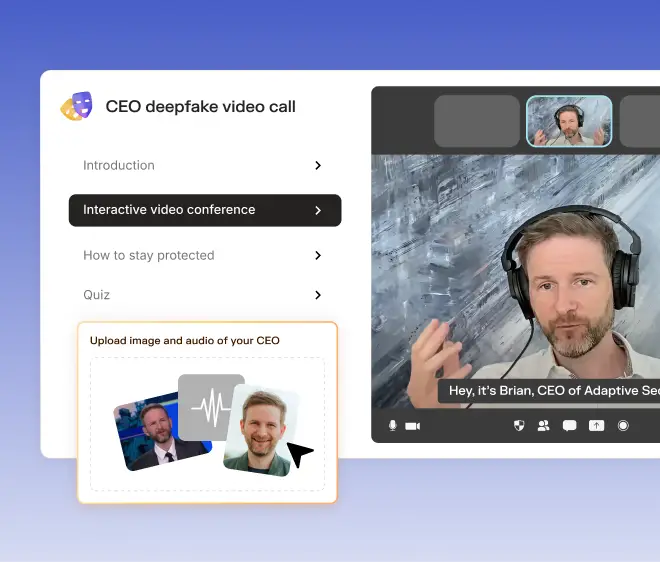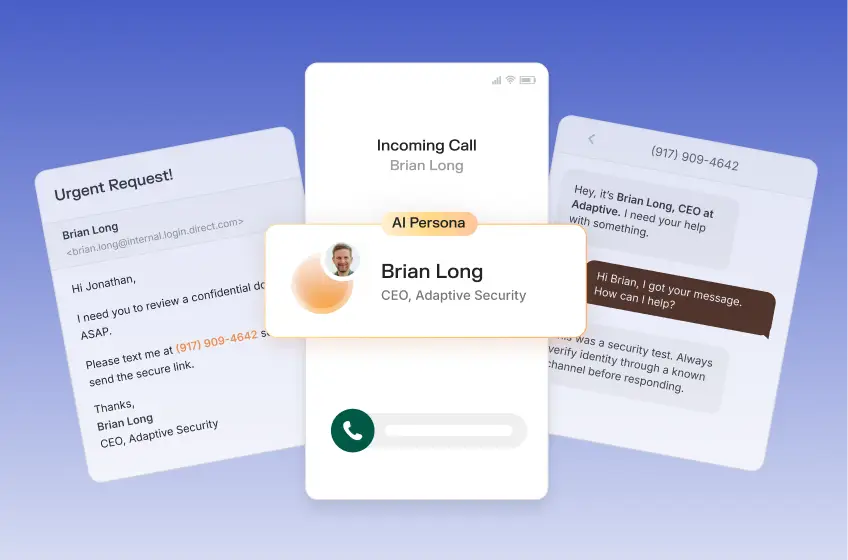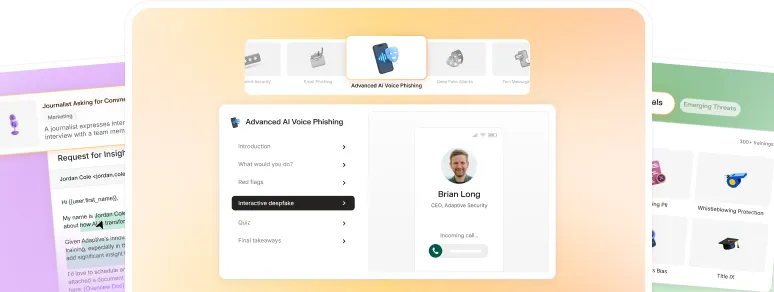Once a cornerstone of trust, the human voice is a new frontier for cybercrime. AI voice cloning scams have surged in recent years, with attackers achieving a 95% voice match and stealing billions of dollars annually.
Attackers can perfectly replicate a voice from just a few seconds of audio, turning an executive’s familiar tone into a weapon for wire fraud or using a trusted colleague’s voice to create a pathway for credential theft. It’s a clear and present danger to organizations of every size.
Yet countless organizations remain vulnerable because employees lack the necessary skill set to identify and respond to voice phishing attacks.
Defending against sophisticated, AI-powered threats like vishing requires a security posture centered around an organization’s most critical asset: the human firewall.
Understanding Modern Voice Cloning Threats
37% of organizations have already faced a deepfake voice attack, a figure that’s climbing rapidly. That’s mainly because the barrier to entry has been significantly reduced.
Attackers don’t need high-end, expensive equipment. Instead, all they need is a public-facing audio recording and an AI tool.
Here’s a quick overview of the terminology and technology at play:
- Voice Cloning: A process using artificial intelligence to analyze and replicate a person’s unique vocal characteristics. The AI model learns the specific pitch, tone, cadence, and inflection from audio samples to create a synthetic, indistinguishable copy.
- Vishing (or Voice Phishing): The fraudulent practice of using a cloned voice to conduct social engineering attacks over the phone. Unlike a generic robocall, a vishing attack is highly personalized and leverages a trusted identity to manipulate the target.
Voice phishing isn’t new. Everyone has dealt with scammers reaching out via phone for decades, but it wasn’t nearly as sophisticated as it is today. Now, with the weaponization of AI for voice cloning, vishing attacks pose a massive threat.
Why social engineers exploit trust in familiar voices
Vishing is one of the most effective types of phishing attacks because it hijacks deep-seated psychological triggers that are difficult to overcome with logic alone, especially under pressure. When an employee hears what they believe to be their boss’ voice in an urgent situation, their brain is wired to comply, not question.
Attackers manipulate several biases during AI voice cloning scams:
- Authority Bias: An employee is conditioned to adhere to instructions from senior leadership, like a CEO or CFO. A cloned voice bypasses the normal skepticism one might have toward a text-based request.
- Urgency: Scammers create a high-pressure scenario, like a confidential deal or an overdue payment to a vendor, that discourages the victim from taking the time to verify the request through normal channels.
- Familial Trust: Attackers target individuals with scams involving clones of family members, often in a fake kidnapping or medical emergency scenario, to extort money from panicked relatives. The same emotional manipulation is used in corporate settings, with attackers posing as distressed colleagues.
Real-world examples are already piling up. In one notorious case, a manager at a United Kingdom-based energy firm was tricked into transferring over $240,000 after his ‘boss’ called, instructing him to make an urgent payment to a new supplier.
As it turned out, the voice was a perfect clone, and the manager only became suspicious after the funds were gone and the real CEO claimed to have never made the call.
Anatomy of Employee-Targeted Voice Clone Scams
Stop an attacker? Get ready to think like one. Understanding the end-to-end process of AI voice spoofing reveals multiple points where a well-prepared organization can break the attack chain.
How attackers harvest voice samples in seconds
An attacker’s raw material for any voice cloning attack is an audio sample, and it’s not difficult to find a recording using open-source intelligence (OSINT) in a hyper-connected world.
The technology powering this is a generative adversarial network (GAN), a sophisticated AI framework where two neural networks, a ‘generator’ and a ‘discriminator,’ compete against each other. The generator creates synthetic voice clips, and the discriminator judges the authenticity in a process repeated millions of times until the output is indistinguishable from the real thing.
Modern GANs can create a convincing clone with as little as three seconds of clear audio.
Attackers harvest the short-yet-crucial seconds of audio from a wide range of public sources:
- Corporate websites
- Conference appearances and webinar recordings
- YouTube clips, podcasts, and media interviews
- Public-facing voicemail greetings
- Social media videos
Any of these readily available sources provides more than enough material for a convincing voice clone.
Step-by-step walkthrough of a CEO fraud call
To illustrate how the elements of an AI voice cloning scam combine, let’s walk through a common scenario.
Here’s a typical timeline for a vishing attack targeting a mid-level finance employee:
- Reconnaissance: The attacker identifies a target organization and a key executive, then finds a 10-second clip of the CEO speaking in a webinar posted on YouTube.
- Voice Cloning: Using an AI voice cloning tool, the attacker uploads the audio sample. Within minutes, they’re provided with a functional model that converts any text type into words uttered in the CEO’s voice.
- Target Identification: The attacker uses LinkedIn to identify an employee on the finance team who is likely to handle wire transfers. They also note the CEO’s upcoming travel plans from social media, planning the attack for when the CEO is on a flight and unreachable.
- Initial Vishing Call: The attacker spoofs the CEO’s phone number and calls the finance employee. The AI voice clone states: “Hi Sarah, it’s John. I’m about to board a flight, but we have an urgent situation, and I need you to process a wire transfer of $75,000 for a vendor’s down payment. I’m emailing you the details now, and please get this done within the next 45 minutes.”
- Follow-Up Malicious Email: The employee immediately receives an email from a spoofed address that appears to be from the CEO, containing fraudulent wire instructions. The combination of the trusted voice and the official-looking phishing email creates a powerful illusion of legitimacy.
- Funds Transfer: Under pressure and believing the request is genuine, the employee bypasses standard procedure and processes the wire transfer. The funds are sent to a bank account controlled by the attacker and are quickly transferred offshore, making them untraceable.
The entire process, from reconnaissance to payout, can take less than an hour, resulting in a devastating financial loss and a compromised sense of security that permeates throughout the organization.
Proven Voice Cloning Defenses That Actually Work
No, there isn’t a ‘silver bullet’ to stop AI voice cloning scams. But an effective defense relies on a layered security stack that combines technology, process, and people.
The most effective defenses are underpinned by robust security awareness training and phishing simulations, which prepare employees to be active participants in the organization’s security posture.
Strategy #1: Build a zero-trust callback workflow
Building a zero-trust callback workflow is the most effective, low-cost defense to implement. Create a mandatory, non-negotiable policy that any unsolicited phone call requesting a sensitive action — such as transferring funds, changing payment details, or providing credentials — must be verified through an out-of-band channel.
Here’s the workflow:
- Incoming Request: An employee receives an urgent call.
- Acknowledgement & Terminate: The employee politely acknowledges the request and informs the caller they’ll call back through an official channel to verify. They then hang up.
- Verify & Call Back: The employee looks up the requester’s number in the official company directory (not from the incoming caller ID) and calls them back to confirm the legitimacy of the request.
It’s a simple process that foils any voice cloning attempt, as the attacker cannot intercept the callback to a trusted number. However, this procedure can only be drilled into employees’ mindsets through regular training and simulations until it becomes an automatic reflex.
Strategy #2: Deploy real-time deepfake audio detection
For high-stakes environments like call centers or financial trading desks, supplement human training with technology. AI-powered deepfake detection technology can analyze calls in real time to identify signs of synthetic audio that are imperceptible to the human ear.
Platforms like Pindrop Pulse analyze vocal tracts, background noise, and other artifacts to determine if a voice is live or machine-generated, providing a risk score to the agent before they take action.
Strategy #3: Train ears with phishing simulations
Employees can’t detect a threat they’ve never (knowingly) encountered, so security awareness training for AI voice cloning scams needs to include vishing simulations.
Adaptive Security allows organizations to run campaigns in which employees experience simulated, fraudulent calls complete with AI-cloned voices of executives and colleagues. The controlled exposure trains employees to recognize the social engineering tactics used in real attacks.
When utilizing vishing simulations, the goal is to track measurable outcomes, such as:
- False-Negative Rate: The percentage of employees who fall for the simulated scam.
- Reporting Rate: The percentage of employees who correctly identify the call as fraudulent and report it through the proper channels.
- Response time: How quickly employees disengage from the call and initiate the callback workflow.
Consistent training with these metrics in mind helps build a reflexive skepticism in employees, which is a critical human defense layer.
Strategy #4: Layer voice biometrics with hardware-based MFA
Relying on a voice alone is no longer safe for internal authentication, such as an employee calling the IT team for a password reset.
Implement a layered approach that combines voice biometrics with a strong second factor. A voice blueprint, which is a unique mathematical representation of a person’s voice, can be used as one factor in determining a person's identity. Still, it needs to be paired with something the user already has, such as a hardware-based multi-factor authentication (MFA) token, like a YubiKey or FIDO2-compliant device.
Research consistently shows that enabling MFA blocks up to 99.9% of attacks, making this combination a powerful defense against AI voice cloning scams seeking to steal credentials and access accounts.
Strategy #5: Executive voice data from public channels
Conduct a thorough audit of the organization’s digital footprint to identify and potentially remove some publicly available audio samples of high-level employees.
Here’s an audit checklist:
- Company website (promotional videos, interviews)
- Archived webinars and conference speaking engagements
- Podcast guest appearances
- Social media channels
- Media interviews
Work with the legal and marketing teams to issue takedown requests where possible. For future appearances, implement a controlled release policy and consider using digital watermarking technology that helps trace the origin of a leaked audio sample.
Strategy #6: Establish crisis-code or ‘safeword’ protocols
Particularly within finance and leadership teams, establish a verbal ‘safeword’ protocol. It’s a unique word or phrase, unrelated to the business, that must be stated to verify the authenticity of a high-stakes verbal request.
The safeword should be known only to a small, select group of individuals. It must be changed regularly and distributed through a secure, out-of-band channel, such as in-person or an encrypted messaging app.
As a simple, espionage-inspired technique, this strategy is incredibly effective at stopping even the most convincing deepfake.
Strategy #7: Monitor and log voice traffic for anomaly patterns
Treat voice traffic like network traffic by monitoring for anomalies. By integrating a VoIP system with a security information and event management (SIEM) platform, IT and security teams can flag suspicious call patterns in real time.
Set up alerts for unusual activity, such as calls originating from unexpected geographic locations, abnormal pitch contours or speaking rates in a known executive’s voice, or multiple failed authentication attempts in a short period. Then, retain the call logs for at least 90 days to support forensic review in the event of an incident.
A Prepared Workforce is the Strongest Defense
AI-powered voice cloning turned trust itself into a vulnerability. Attackers are armed with technology to convincingly mimic the most trusted form of communication, and while defense technologies like deepfake detection and voice biometrics provide a critical layer of defense, they can’t be alone.
The most resilient and cost-effective shield from voice cloning scams remains a well-trained, empowered workforce.
Combining robust technical controls with pragmatic procedures and continuous, simulation-based phishing training for employees builds a formidable human firewall. The goal is to cultivate a culture where every employee feels confident and equipped ot question the unexpected, verify every sensitive request, and serve as an active defender of the organization.
Defending against sophisticated, AI-powered threats like vishing requires a security posture centered around an organization’s most critical asset: the human firewall.




We are a team of passionate technologists. Adaptive is building a platform that’s tailor-made for helping every company embrace this new era of technology without compromising on security.
Contents



Want to download an asset from our site?





.avif)
.avif)